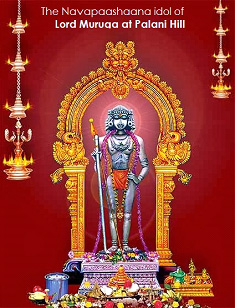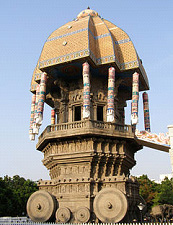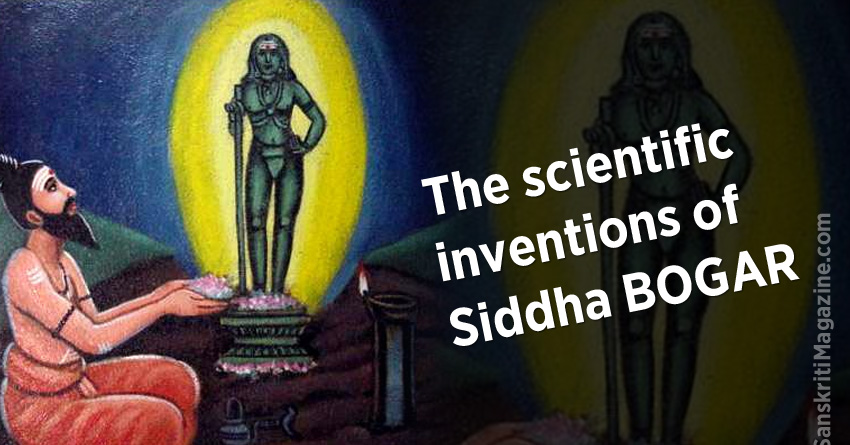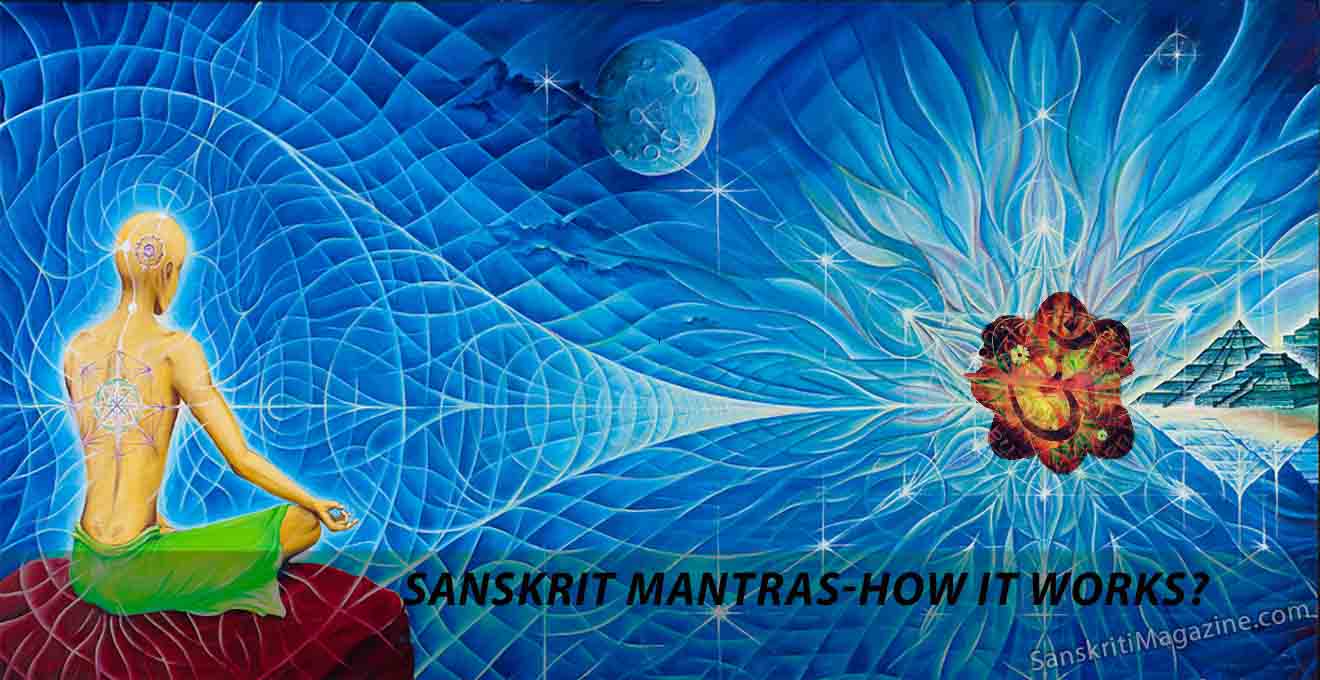With reverential obeisance to the holy feet of my beloved guru BOGAR, I take this moment to showcase his technical inventions and scientific experiments. The mystic man Bogar is considered to be one of the 18 siddha purushas of the siddha lineage in South India.
Lord Shiva being the Aadhi siddha himself had bestowed upon Sage Agasthya to have foremost authority over the group. It was Bogar who used nine poisons with herbal extract and sculpted the existing divine statue of Lord Muruga at Palani hill in Dindigul district of Tamilnadu. Panchapaashaanam, Navapaashaanam, Dasapaashanam are different chemical compositions that remain sturdy for several thousand years. The holy water after ablution (abisheka) to idols made of the pashaana composition cures hundreds of known diseases.
In 2013 I published an abridged concise treatise in Tamil for the mega work ‘Bogar-7000’. The original lengthy poetry composed in Tamil with seven thousand songs is called Sapthakaandam as it has seven kanto comprising 1000 songs in each. Each song has four verses set to alliteration of classical Tamil grammar meter. Siddha Bogar has to his credit several thousand voluminous compositions spreading over topics like medicine, elixir, oceans of birth, procedure to invoke shiva-shakthi, epic of wisdom, mastering ashta siddhi, stages of samadhi, black magic, salts, alchemy, airplane, ship building, etc. It is believed Bogar left China around 4 BC and later attained Nirvikalpa samadhi in 7 AD at Palani. Through his divine revelation, I had the opportunity to have his darshan in his current form.
 For several aeons Bogar has been under the tutelage of his guru Kaalaangi, and mastered the nuances of wisdom. Under instructions from his guru, Bogar took the form of a Chinese old man Laotzu, and has been living thence for several yugas. He chose China for various good reasons and proximity to the Himalayas (Meru hill). Sage Agasthya had himself showered praises on Bogar as the ‘Flying Siddha who rarely remained on earth’. With the assistance of his faithful disciple Pulipani, Bogar chalked the ways of performing pooja and formulated steps to preserve his masterpiece statue carved out of Naavapaashaana. He had said that Sathuragiri is the head quarters of all siddhas. A hilly terrain situated in the Srivilliputhur taluk of Tamilnadu, it is the abode of Lord Shiva that is respected equally to Mount Kailash.
For several aeons Bogar has been under the tutelage of his guru Kaalaangi, and mastered the nuances of wisdom. Under instructions from his guru, Bogar took the form of a Chinese old man Laotzu, and has been living thence for several yugas. He chose China for various good reasons and proximity to the Himalayas (Meru hill). Sage Agasthya had himself showered praises on Bogar as the ‘Flying Siddha who rarely remained on earth’. With the assistance of his faithful disciple Pulipani, Bogar chalked the ways of performing pooja and formulated steps to preserve his masterpiece statue carved out of Naavapaashaana. He had said that Sathuragiri is the head quarters of all siddhas. A hilly terrain situated in the Srivilliputhur taluk of Tamilnadu, it is the abode of Lord Shiva that is respected equally to Mount Kailash.
Siddha Bogar had fathomed the essence of the works of seniors and contemporaries. He had studied all the scriptures through thousands of years at Meru hill. Through the words of Bogar, it is understood that the samadhi of books (libraries) are on the western side of Meru. Each time at the onset of apocalypse, all rishis reached the cliff with the heaps of scriptures and palm leaf manuscripts, only to leave with the custodian Lord Shiva. Now what we claim as the snow peak Kailasa is the store house of books. Bogar claims to have read and digested the contents in no time. His narration ‘In Kaliyug, the people living south of Himalayas will not even get to read at least 1% of what I read’ makes us spellbound.
Hope you are aware of the controversy on Vaimanika shastra that erupted at the Indian Science Congress held last year. Now after going through the achievements of my beloved guru, I can strongly say that Vimanika shastra is true and can be interpreted with reference to other similar ancient scriptures that are available. Prior to siddha Bogar, rishis like Bhardwaja, Ashwini, Tiruvela, Kashyapa had made and flown indigenous vimanas. Though fuels varied, the purpose of the machine served. They had flown and crossed several yojanas in few minutes. The Vaan Ratha as Bogar called it existed in gold, silver, and alloy of five metals, panchaloka / panchadhathu. Owing to the colour of alloy mixture it was reddish and he coined it Sempuravi in Tamil (the red chariot). The typical shape described by him appeared like temple chariot. Since it resembled the gopura vimana of temple, the flying plane was called a vimana. In my view, he is the only siddha to have constructed and operated several airplanes to fly across seven seas carrying rishis and Chinese folks on a joy ride.
 After roaming over sapthasagara (Red Sea, Caspian Sea, Black Sea, Dead Sea, Indian Ocean, China Sea, Persian sea), he returned to China and offloaded the people who were in disbelief and joy. In fifth kanto, he mentions the sea abutting Gulf and Gujarat coast as Krishna samudra. He was the one who built a gigantic ship with wood and iron measuring 800 yards in length, 100 yards in breadth and 100 yards in height. It had seven tiers, decks and a fort of 64 apartments with sufficient glass windows facing North-South and doors facing East-West. His ship ran on powerful steam engines. With well laid hard core pipes to carry hot steam across the floor to operate pistons in turbine engines and rotate the propeller, he ensured the pipes were leak proof and conveyed high pressure hot steam. With high rise chimneys for letting out smoke, he erected the steering on the top deck to facilitate his view of sail. Details on ship building are described in his songs (No: 1927 -1945). Thus he wrote:
After roaming over sapthasagara (Red Sea, Caspian Sea, Black Sea, Dead Sea, Indian Ocean, China Sea, Persian sea), he returned to China and offloaded the people who were in disbelief and joy. In fifth kanto, he mentions the sea abutting Gulf and Gujarat coast as Krishna samudra. He was the one who built a gigantic ship with wood and iron measuring 800 yards in length, 100 yards in breadth and 100 yards in height. It had seven tiers, decks and a fort of 64 apartments with sufficient glass windows facing North-South and doors facing East-West. His ship ran on powerful steam engines. With well laid hard core pipes to carry hot steam across the floor to operate pistons in turbine engines and rotate the propeller, he ensured the pipes were leak proof and conveyed high pressure hot steam. With high rise chimneys for letting out smoke, he erected the steering on the top deck to facilitate his view of sail. Details on ship building are described in his songs (No: 1927 -1945). Thus he wrote:
‘Built a massive ship to accommodate thousand people
Chinese aghast with calculated formula on wooden planks;
Decided on impeccable geometry to make the floating giant
Stood on iron nailed pillars and turbine powered by hot steam’
It leaves us speechless to visualize the extent of woods that were chopped, treated, shaped and nailed in place. The magnitude of iron, glass and ropes required, the overall labour involved in the execution of project with perfect trigonometry, hydraulics, mechanics and dynamics of viscosity –buoyancy, would certainly leave us guessing.
 In song 2204, he narrates how he designed the Aero-chariot, the Vaan Rathaa, much to the astonishment of kings. His vertical chariot measuring 30 yards in breadth, 100 yards in height with 3 cylindrical stages had strong base with wheels and adjustable stilt to support corners. It ran without being pulled by horses (Asvamilla vandi). He describes the structure as fuelled by burning coal to heat the boiler. The hot steam rotated the magnetic propeller to swiftly rise up the sky with booming noise. Bogar says that all panchabootha elements play a vital role in the flight dynamics. He flew over China over a range of 30 km in sky. However, readers may imagine the basic shape of the temple Rathas of South India as shown here. It is understood he used black magnets to improve electromagnetic force.
In song 2204, he narrates how he designed the Aero-chariot, the Vaan Rathaa, much to the astonishment of kings. His vertical chariot measuring 30 yards in breadth, 100 yards in height with 3 cylindrical stages had strong base with wheels and adjustable stilt to support corners. It ran without being pulled by horses (Asvamilla vandi). He describes the structure as fuelled by burning coal to heat the boiler. The hot steam rotated the magnetic propeller to swiftly rise up the sky with booming noise. Bogar says that all panchabootha elements play a vital role in the flight dynamics. He flew over China over a range of 30 km in sky. However, readers may imagine the basic shape of the temple Rathas of South India as shown here. It is understood he used black magnets to improve electromagnetic force.
In song 2215-2220, he describes the route travelled and the cities to which he had flown. He had used the Tamil system of linear scale Kaadham, meaning 10 miles. In nutshell:
‘Beyond eight hundred kaadhams, carried rishis and Chinese to Rome
Alighted at the tomb of Roman charioteer, saw the samadhi of Jesus;
Seen seventy nations around and countless rishis on the land of Jews
Off loaded people in their lands after seeing wonders of the world’
His songs narrate the physical appearance, glow, sound properties and driving mechanism. With flair to ride on Ashwini maharishi’s airplane, Bogar disclosed his wish and had permission to drive. It appears the plane driven with joystick also obeyed to oral command. Bestowed with Lahima, siddhas generally travelled the space through flying mode (Gegana siddhi) by keeping a special Gulikha in mouth till they descended to earth. Song 4485 says,
‘Visited the ashrama of Ashwini, sighted the airplane with joy in wild dense
After breath control, climbed over with gulikha on hand, flew to the far off;
As instructed by maharishi, stewarded right and left to perfectly land in vicinity
Oh! The fuel power had run down and your flight is again on earth my son.’
His song 4513 has proof of his demonstration as to how he successfully explored and tested the voice synthesis of oral command as instructed by Maharishi.
‘To my wish and command, the plane should obey oral orders
Become still at the touch of my fingers to descend at the street;
Maharishi taught machine language to control it as desired
Generous enough to allow me to take it to the land of China’
Bogar has lived through many yugas and seen apocalypses. The songs give a hint that he was active in society until he went into samadhi around 7AD. Besides airplane and steamer, Bogar had invented many scientific tools for the welfare of mankind. Personally I am of the opinion that many literary works of Tamil siddhas were not explored in the past and research being restricted to Sanskrit scriptures. With proper approach and research, it can be established that several advanced scientific methodologies were put to use in ancient Bharatham. The third kanto of Sapthakaandam throws light on the technical innovations of the scientist, siddha Bogar. He is the pioneer of many modern tools that are presently used.
Ceramic, SCUBA apparatus, parachute, hot air balloon, plain and tinted glass, mirror, underwater telescope, magnifying lens, spectacle, handmade paper, automatic printing machine, kaleidoscope, dielectric , thermo couple, electroplating, artificial gem etc. are his inventions. Sage Agasthya maharishi embraced and praised him saying ‘Long live my vigyana siddha’. In song 2381, he narrates the secrets of glass making and reflective mirror. After making the plain glass without color tints, he applied hot coat of Lead amalagam on one side. This gave the perfect result of mirror which all siddha rishis welcomed.
‘Treated mercury partially on glass I meticulously made
Saw my bright face on the mirror with perfection as it was;
Siddha rishis thronged to glimpse, praised me for the invention
What is the use of decoration if the beauty is not visible to thy?’
Thus he taught many technical details to Chinese, whom he certifies as ‘innocent and pure’. Other rishis acclaimed that there is no scientist to match his wisdom on earth, as sage Agasthya has certified Bogar as the flying Aathi siddha (though Lord Shiva is the first Aadhi siddha). Bogar had extensively travelled to many continents
Another magnificent work Bogar 12000 is said to contain minute details of nuclear products, fission, fusion; ambrosia for all diseases to occur in kaliyuga, constructing special planes to outer planets, existence of aliens, geo properties of Jupiter and Mars, acoustics, metrology, land survey and other related branches of science and technology. Every Indian should feel proud of the siddhas who had built Bharatham as the most civilized and advanced nation, long before human settlement and civilization began in other parts of the world.
===============
About the Author:
S.Chandrasekar, a resident of Chennai is an HR specialist and trainer.
He has authored 20 books in Tamil. It includes Athisaya Siththar Bogar, Bogar 7000: A concise treatise, Siddha’s contribution to science and technology, Siddha Prapancham.
He can be reached at chandruselva@gmail.com












